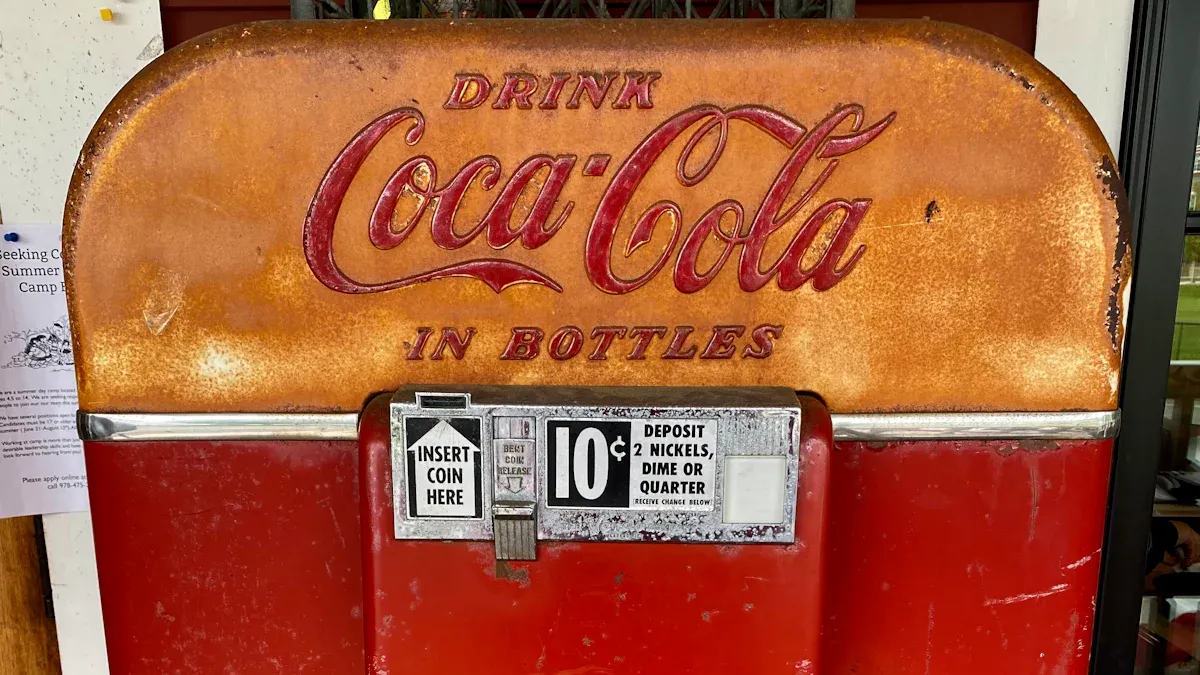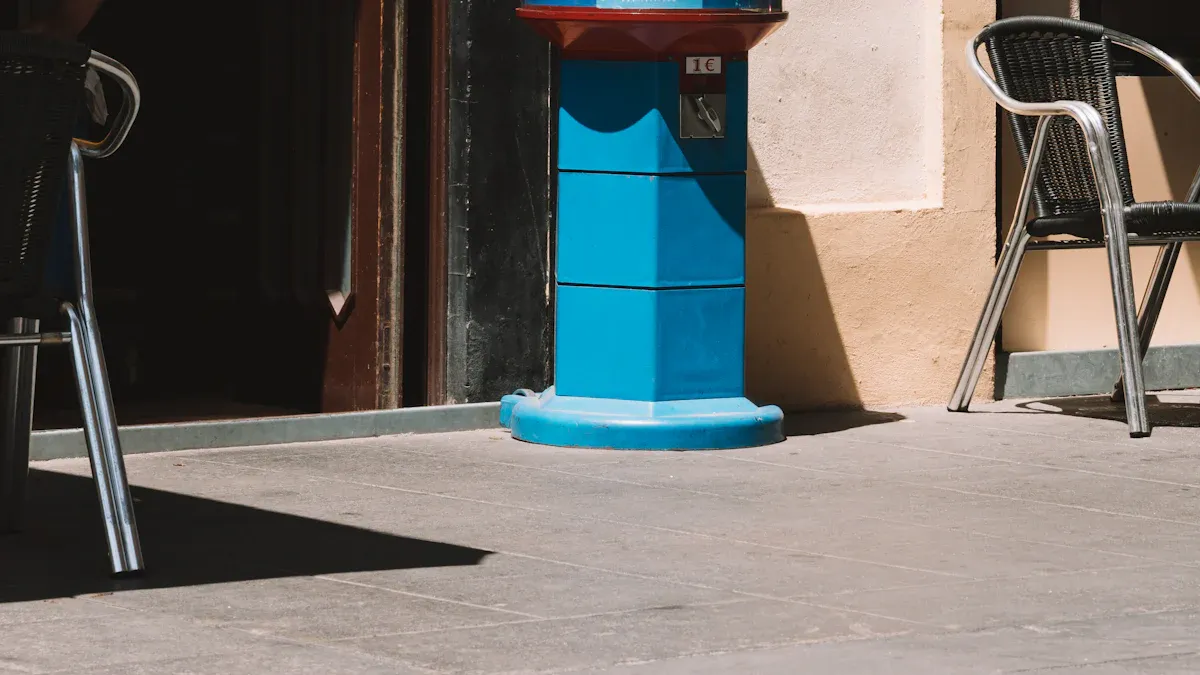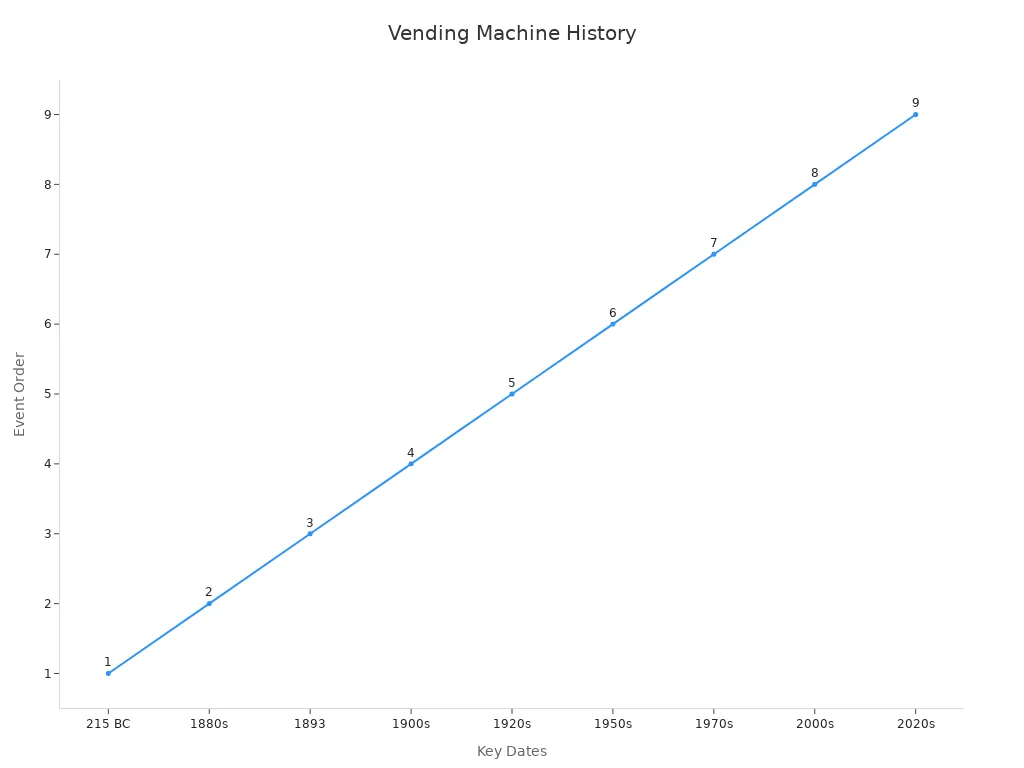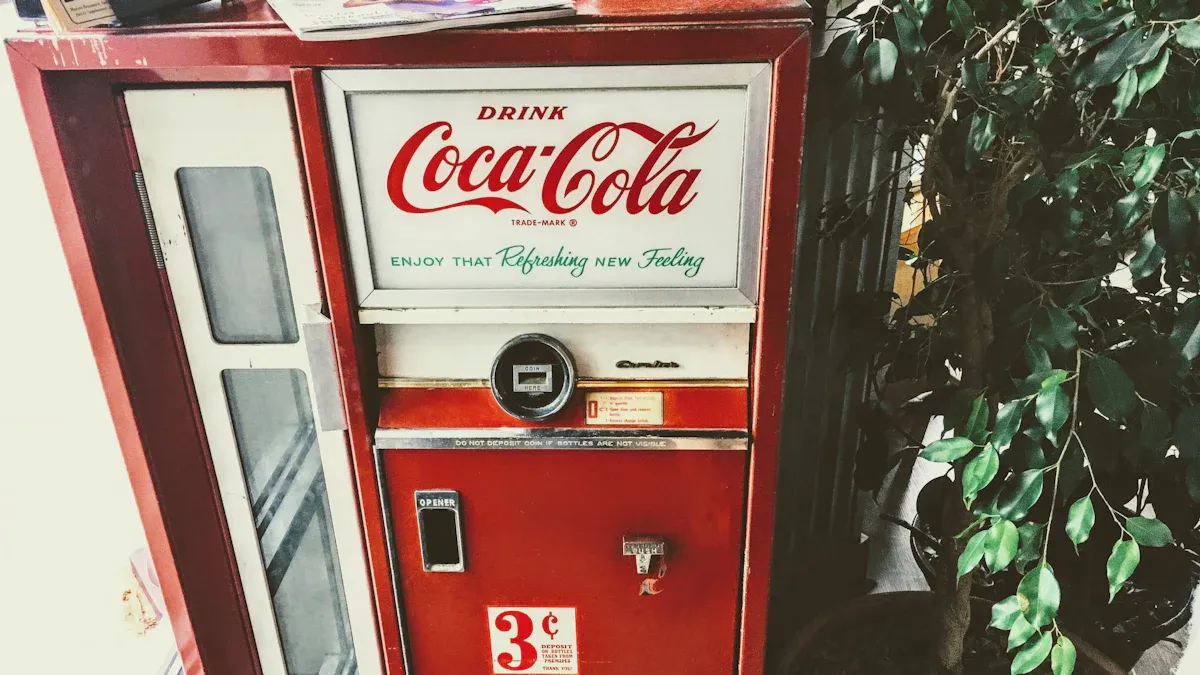Vintage Snack Vending Machines

Do you remember the thrill of grabbing a snack from a vending machine? Vintage snack vending machines take that feeling to the next level. These machines don’t just dispense treats—they serve up nostalgia. Their bold designs, colorful knobs, and satisfying mechanical clicks make them feel like little time capsules.
People love them for more than just their looks. Millennials, for example, crave products with personality, and vintage vending machines deliver just that. They’re familiar, convenient, and offer a unique experience that stands out in today’s tech-heavy world. In tough times, like dealing with student debt or job struggles, the comfort of nostalgia becomes even more appealing.
Key Takeaways
Old snack vending machines bring back memories with their cool looks and simple mechanics, making them more than just snack holders.
These machines were important in the past. They made snacks easy to get in schools, offices, and public places, showing how culture changed over time.
Fixing old vending machines can be a fun hobby. Find ones in good shape and be ready to fix them to keep them working.
Even with new technology, old machines are still loved. They are charming and remind people of easier, happier times.
Collecting old vending machines can be exciting. Check flea markets, online shops, and collector groups to find special ones.
The History of Vintage Snack Vending Machines

Early Origins of Vending Machines
Did you know vending machines date back over 2,000 years? The first known vending machine was invented by Hero of Alexandria in 215 BC. It wasn’t dispensing snacks, though—it gave out holy water when you dropped a coin into it. Fast forward to the 1880s, and the first commercial vending machines appeared in London, selling postcards. By 1893, vending machines had made their way to the World’s Fair in Chicago, offering soda to thirsty visitors.
Here’s a quick look at how vending machines evolved over time:
Date | Event |
|---|---|
215 BC | Hero of Alexandria invented the first vending machine for holy water. |
1880s | London introduced postcard vending machines. |
1893 | Soda vending machines debuted at the World’s Fair in Chicago. |
1900s | Vending machines gained popularity in the U.S., selling postcards. |
1920s | Snack and candy vending machines appeared for the first time. |
1950s | Coin-operated vending machines became widespread in the U.S. |
1970s | Snack and beverage vending machines became common in schools and offices. |
2020s | Smart vending machines with touchscreens and IoT connectivity emerged. |
The Rise of Snack Vending Machines
Snack vending machines didn’t just pop up overnight. They started gaining traction in the 1920s, offering candy and small treats. By the 1950s, coin-operated machines were everywhere, making it easy for people to grab snacks on the go. These machines became staples in schools, workplaces, and public spaces during the 1970s.
What made them so popular? Convenience was key. You didn’t need to wait in line or interact with anyone—just drop a coin, press a button, and enjoy your snack. Plus, the machines were reliable and easy to use, which made them a hit with busy people.
Key Milestones in Their Evolution
Snack vending machines have come a long way. Here are some of the most important milestones:
1st century CE: Hero of Alexandria’s holy water dispenser paved the way for vending technology.
1888: The Thomas Adams Gum Company introduced the first vending machines in the U.S., selling Tutti-Fruiti gum.
1902: Horn & Hardart opened a restaurant in Philadelphia that operated entirely on vending systems.
1937: Coca-Cola partnered with Vendo Company to launch soft-drink vending machines.
1926: William Rowe invented the first cigarette vending machine.
1897: Pulver Manufacturing Company added animated figures to gum machines, making them more entertaining.
Snack vending machines have evolved from simple mechanical devices to modern marvels equipped with touchscreens and cashless payment systems. Today, they’re not just functional—they’re part of our culture and history.

Unique Features of Vintage Snack Vending Machines
Iconic Designs and Aesthetics
When you think of vintage snack vending machines, their eye-catching designs probably come to mind first. These machines weren’t just functional—they were works of art. Bright colors, bold fonts, and retro logos made them impossible to miss. Some even featured glass fronts, letting you peek at the snacks inside. This added a sense of excitement as you decided what to buy.
Many machines also had unique shapes. For example, Coca-Cola’s vending machines in the 1950s were shaped like refrigerators, complete with rounded edges and chrome accents. These designs weren’t just about looks—they reflected the trends of their time. They gave each machine a personality, making them memorable and fun to use.
Mechanical vs. Digital Mechanisms
One of the coolest things about vintage snack vending machines is how they worked. Unlike today’s digital machines, which rely on touchscreens and sensors, vintage machines used mechanical systems. You’d insert a coin, turn a knob, or pull a lever to get your snack. The clinking sound of the coin and the satisfying click of the mechanism made the experience feel hands-on and interactive.
These machines were marvels of engineering. Some even included innovative features for their time. In 1937, Vendo introduced refrigeration technology, allowing vending machines to store cold drinks and perishable snacks. This was a game-changer. Suddenly, you could grab a chilled soda or a fresh sandwich on the go. Later, heating elements were added to some machines, making it possible to enjoy hot foods like coffee or soup. These advancements made vending machines more versatile and appealing to consumers.
Popular Snacks Dispensed
What snacks could you find in vintage snack vending machines? The options were simple but satisfying. Candy bars, gum, and chips were the most common choices. You might also find peanuts, crackers, or small pastries. These snacks were affordable and easy to package, making them perfect for vending machines.
In the 1950s and 1960s, soda became a popular addition. Machines stocked glass bottles of Coca-Cola, Pepsi, and other fizzy drinks. Some machines even offered regional snacks, giving them a local flavor. This variety made vending machines a convenient option for a quick treat, whether you were at work, school, or a train station.
Even today, these snacks bring back memories for many people. Seeing a vintage machine stocked with old-school treats can transport you back in time, reminding you of simpler days.
Cultural Significance of Vintage Snack Vending Machines
Their Role in Society
Vintage snack vending machines weren’t just about snacks. They played a big role in shaping how people accessed food on the go. These machines made it possible for you to grab a quick treat without needing to visit a store or café. They popped up in schools, offices, and train stations, becoming a part of everyday life.
For businesses, they were a game-changer. Companies could offer snacks to employees without needing a full cafeteria. Schools used them to provide students with affordable snacks during breaks. Even small towns benefited, as vending machines brought convenience to places without many stores.
These machines also reflected the culture of their time. The snacks they offered often mirrored popular trends, like the rise of soda in the 1950s or the introduction of healthier options in later decades. They weren’t just machines—they were a snapshot of society’s tastes and habits.
Nostalgia and Emotional Connection
There’s something magical about vintage snack vending machines. Maybe it’s the sound of the coin dropping or the thrill of watching your snack slide down. These little moments stick with you, creating memories tied to simpler times.
For many, these machines bring back childhood memories. You might remember saving up coins to buy your favorite candy bar or sharing a soda with friends after school. That emotional connection is why vintage vending machines still hold a special place in people’s hearts.
Even today, seeing one of these machines can make you smile. It’s like stepping into a time machine, reminding you of a world before smartphones and touchscreens. That nostalgia is powerful, offering comfort and a sense of connection to the past.
Representation in Pop Culture
Vintage snack vending machines have made their mark in movies, TV shows, and even music videos. They’re often used as symbols of nostalgia or to set the scene in a retro-themed story. Think about how many times you’ve seen a character grab a soda from a vending machine in a 1950s diner or a high school hallway.
These machines also appear in art and photography. Their bold designs and bright colors make them perfect for capturing a retro vibe. Some artists even use them as inspiration for sculptures or installations.
In pop culture, they’re more than just machines. They’re icons that represent a specific time and place. Whether it’s a classic movie or a modern music video, vintage snack vending machines continue to capture the imagination of creators and audiences alike.
Comparing Vintage and Modern Vending Machines
Differences in Technology and Functionality
When you compare vintage snack vending machines to modern ones, the differences are striking. Vintage machines relied on simple mechanical systems. You’d drop a coin, turn a knob, or pull a lever to get your snack. These machines were charming but limited. They only accepted coins, and their product selection was small.
Modern vending machines, on the other hand, are technological marvels. They accept cash, cards, and even mobile payments. Some machines use touchscreens and sensors to make the process faster and more interactive. Here’s a quick comparison:
Metric | Vintage Vending Machines | Modern Vending Machines |
|---|---|---|
Lower due to limited payment options | Higher thanks to diverse payment methods | |
Stock Turnover Rate | Lower, with fewer purchases | Higher, showing active customer engagement |
Machine Downtime | Frequent due to older technology | Reduced with advanced maintenance systems |
Customer Satisfaction | Lower due to limited features | Higher with better user experience |
Payment Methods | Cash only | Cash, cards, and mobile payments |
These advancements show how vending machines have evolved to meet your needs, offering more convenience and variety than ever before.
Why Vintage Machines Remain Popular
Despite all the modern upgrades, vintage snack vending machines still hold a special place in people’s hearts. Why? It’s all about nostalgia. These machines remind you of simpler times. The sound of a coin dropping or the click of a lever feels personal and satisfying.
Vintage machines also stand out because of their unique designs. Their bold colors and retro logos make them perfect for collectors or anyone looking to add a touch of history to their space. Plus, they’re a reminder of how far technology has come, making them both functional and sentimental.
Modern Innovations Inspired by Vintage Machines
Modern vending machines often borrow ideas from their vintage counterparts. For example:
Some machines now feature retro-inspired designs, blending old-school aesthetics with new technology.
Art vending machines, which sell small artworks, are repurposed from traditional snack machines.
You’ll even find vending machines in unexpected places, like cafes or bars, creating unique shopping experiences.
These innovations show how vintage machines continue to inspire creativity. Whether it’s through design or functionality, their legacy lives on in today’s vending technology.
Collecting and Restoring Vintage Snack Vending Machines

Where to Find Vintage Machines
If you’re looking to start your collection of vintage snack vending machines, you’re in for an exciting treasure hunt. These machines often pop up in unexpected places, so keeping an open mind is key. Flea markets and antique shops are great starting points. You might stumble upon a hidden gem tucked away in a corner. Estate sales can also be goldmines, especially if the previous owner had a knack for collecting retro items.
Online marketplaces like eBay and Craigslist are another option. They offer a wide variety of machines, but you’ll need to do your homework. Check the seller’s reviews and ask for detailed photos before making a purchase. If you’re lucky, you might even find a local seller, saving you the hassle of shipping.
For serious collectors, auctions and specialty dealers are worth exploring. These sources often have rare or high-quality machines, but they can be pricey. Joining collector forums or social media groups can also help you connect with other enthusiasts. They might share tips, leads, or even sell machines directly.
Tips for Restoring and Maintaining Them
Restoring a vintage snack vending machine can be a rewarding project. It’s like bringing a piece of history back to life. Start by assessing the machine’s condition. Look for rust, broken parts, or missing components. A thorough cleaning is usually the first step. Use mild soap and water to remove dirt and grime, but avoid harsh chemicals that could damage the finish.
Next, focus on the mechanics. If the machine doesn’t work, check the coin mechanism and dispensing system. These parts often need lubrication or minor repairs. For electrical components, like lights or refrigeration units, you might need to replace old wiring. If you’re not comfortable with electrical work, consider hiring a professional.
Here’s a glimpse into what restoration might involve, based on collector experiences:
Date | Action Taken | Challenges Encountered |
|---|---|---|
04-05-2005 | Heavy to carry, initial condition assessment | |
Cleaned all surfaces | Lots of dirt, minimal rust | |
Replaced front glass | Cracked and missing corners | |
Rebuilt wiring harness | All wiring completely gone | |
Replaced lights | All four lights missing | |
Addressed wood chipping on the frame | Structural integrity concerns |
Once your machine is restored, regular maintenance will keep it in top shape. Dust it frequently and check for signs of wear. If it’s a working machine, test it occasionally to ensure everything runs smoothly. Proper care will help preserve its charm and functionality for years to come.
What to Look for When Buying
When buying a vintage snack vending machine, knowing what to look for can save you time and money. Start by checking the machine’s overall condition. Look for rust, dents, or missing parts. A machine in good shape might cost more upfront, but it’ll save you the hassle of extensive repairs.
Pay attention to the brand and model. Some brands, like Vendo or Cavalier, are highly sought after by collectors. Research the machine’s history to understand its value. If it has unique features or a rare design, it could be a great investment.
Functionality is another key factor. Ask the seller if the machine works. If it doesn’t, find out what’s wrong. Minor issues, like a jammed coin mechanism, are usually fixable. But major problems, like a broken refrigeration unit, could be costly to repair.
Finally, consider the price. Compare listings to get a sense of the market value. Don’t be afraid to negotiate, especially if the machine needs work. Remember, the goal is to find a piece that fits your budget and brings you joy.
Vintage snack vending machines aren’t just relics of the past—they’re timeless treasures. Their charm lies in their ability to transport you back to simpler times, offering a slice of nostalgia with every coin drop. Whether you’re a collector or just someone who loves retro decor, these machines bring personality and history into any space.
They’re more than just functional. They’re conversation starters, pieces of art, and a reminder of how far we’ve come. Adding one to your collection isn’t just about owning a machine; it’s about preserving a piece of cultural history.
FAQ
What makes vintage snack vending machines so special?
Vintage snack vending machines stand out because of their nostalgic charm and unique designs. They remind you of simpler times with their bold colors, mechanical knobs, and retro logos. These machines aren’t just functional—they’re pieces of history that bring personality to any space.
Can vintage vending machines still work today?
Yes, many vintage vending machines can still work if they’re well-maintained or restored. You might need to replace some parts, like the coin mechanism or wiring. With proper care, these machines can function just like they did decades ago.
How much does a vintage snack vending machine cost?
Prices vary depending on the machine’s condition, rarity, and brand. A basic model might cost a few hundred dollars, while rare or fully restored machines can go for thousands. Always research and compare prices before buying.
Are vintage vending machines hard to maintain?
Not really! Regular cleaning and occasional checks for rust or wear can keep your machine in good shape. If it’s a working model, test it now and then to ensure everything runs smoothly. For complex repairs, you might need professional help.
Where can I display a vintage snack vending machine?
You can place one in your home, office, or even a café. They make great conversation starters and add a retro vibe to any space. Whether it’s in a game room or a kitchen corner, these machines are both decorative and functional.
Tip: Use your vintage vending machine as a unique storage solution for snacks or small items if you don’t plan to use it for vending.
See Also
Unique Collectibles Found in Vending Machines Today
Edible Vending Machines Transforming Access to Snacks
Exploring the Rich History of Vintage Vending Machines
Space-Efficient Snack Vending Machines for Contemporary Living
The Influence of Cloudpick Machines on Healthy Snack Choices
